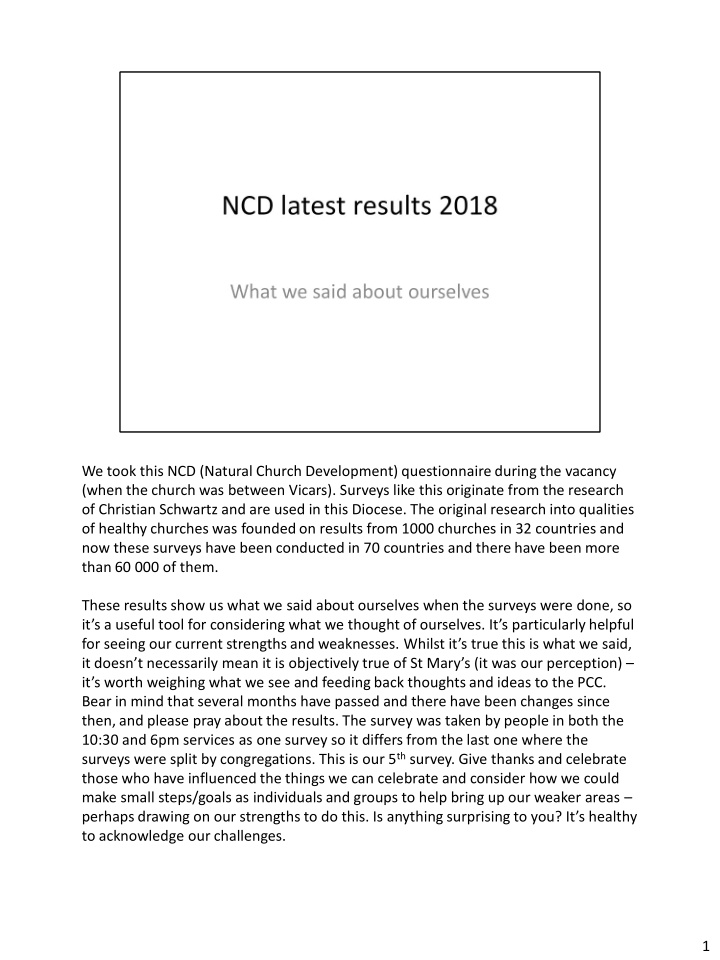



We took this NCD (Natural Church Development) questionnaire during the vacancy (when the church was between Vicars). Surveys like this originate from the research of Christian Schwartz and are used in this Diocese. The original research into qualities of healthy churches was founded on results from 1000 churches in 32 countries and now these surveys have been conducted in 70 countries and there have been more than 60 000 of them. These results show us what we said about ourselves when the surveys were done, so it’s a useful tool for considering what we thought of ourselves. It’s particularly helpful for seeing our current strengths and weaknesses. Whilst it’s true this is what we said, it doesn’t necessarily mean it is objectively true of St Mary’s (it was our perception) – it’s worth weighing what we see and feeding back thoughts and ideas to the PCC. Bear in mind that several months have passed and there have been changes since then, and please pray about the results. The survey was taken by people in both the 10:30 and 6pm services as one survey so it differs from the last one where the surveys were split by congregations. This is our 5 th survey. Give thanks and celebrate those who have influenced the things we can celebrate and consider how we could make small steps/goals as individuals and groups to help bring up our weaker areas – perhaps drawing on our strengths to do this. Is anything surprising to you? It’s healthy to acknowledge our challenges. 1
The solid yellow line shows we’ve become more balanced which is good and the arrow on the left shows we think fellowship comes most naturally to us, then service and then faith. 2
Here we have the 8 essential qualities of healthy growing churches (if churches are doing these things well then the research showed they’d naturally be growing – and not just in numbers, we’re thinking about spiritual growth and fruit ), notice the descriptive words as they matter – Loving relationships (not just relationships, but Loving relationships), Evangelism (that’s need -oriented) … We thought our top quality is Loving Relationships and our lowest factor was Effective Structures (last time our minimum was inspiring worship services). The rest of the survey indicates it’s worth considering Holistic Small groups as part of this as we consider how we might work on the weakest areas. The yellow circles show we saw a drop in scores and that might be expected during a vacancy, interestingly they look more balanced. 3
The grey lines show where we were on the last survey, and here we see the drop in scores (understandable during a vacancy) and see which changed most. The barrel and the staves helps us think about how the lowest stave (the pieces of wood that the barrel’s made of) limits the height of the water it can hold. It’s a metaphor for the health of the church that we’re affected by the minimum factor (effective structures), if we could bring this up then we’d see our health improve. The idea is to aim for high results that are well balanced. Effective structures includes things like administration, how we do our meetings, how we’re organised, communication, strategy, how things get done, it’s like the trellis that holds up a plant, so that all the other good things can happen well. 4
Here we see how we compare with other surveys beyond our church. It’s not simple averages/percentages, but a score of 50 does coincide with 50% of surveys (it’s a bell curve off the 50 point so a score of 35 is equivalent to 15%, 65 is 85% and 80 is 97.5%). So we can see where we are compared with results around the world. We can celebrate that we think we’re doing really well with Loving Relationships and none of the results show us thinking we’re really low at any aspect. So celebrate this! 5
This page illustrates our perceived challenges. Breathing in and out is about how much we are inward looking and how much we are breathing out in outreach. On the everyday-faith theme interestingly we scored ourselves well for trying to deepen our relationships with people who don’t yet know Christ, but low for praying for friends, colleagues and relatives who don ’ t yet know Christ. This is an obvious way we could improve individually and corporately. Themes that come naturally to us include intimacy, affirmation, reconciliation and those that are less natural are everyday-faith, faith stretching and prayer. We’ve been seeing changes in key areas and we can praise God that he’s been leading us to make changes already. For example, our small groups coordinator recently chose to step down from other responsibilities to give more focus to this area and she’s being supported by the Vicar, we have introduced morning prayer meetings, a prayer email, 1 st Priority prayer meetings (our church prayer meetings) and we’ve been individually committing to pray for 2 people who don’t know Jesus yet. In terms of faith stretching we’ve done some new activities like the free community car wash and we can praise God for families who’ve come to church following that, and we’ve been doing more with the SYDNI centre. The Vicar has been working on structures, including seeing people released according to passion and gifting in new ministries/teams, we have newcomers lunches, staff meet weekly and there have been changes in structures being put in place for their wellbeing and support, PCC are going on training etc … Please be praying about your personal next step from what you’ve heard. Please talk to the leaders of the church about your ideas and thoughts (including the Vicar, PCC, wardens) and others Please encourage each other – there is so much to celebrate here. 6
Recommend
More recommend